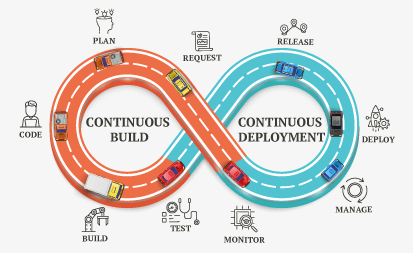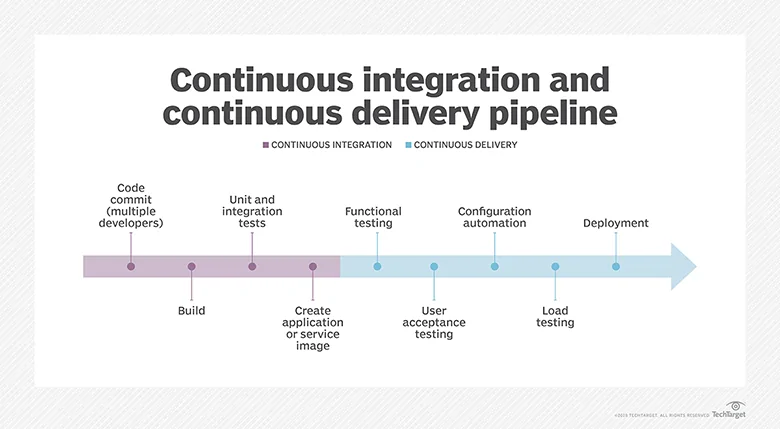DevOps is the acronym given to the combination of Development and Operations. It refers to a collaborative approach to make the Application Development team and the IT Operations team of an organization to seamlessly work with better communication. It is a philosophy that encourages adopting iterative software development, automation, and programmable infrastructure deployment and maintenance.
DevOps emphasizes building trust and better liasioning between developers and system administrators. This helps the organization in aligning technological projects to business requirements. Changes rolled out are usually small and reversible, which the entire team begins to comprehend.
DevOps is visualized as an infinite loop comprising the steps: plan, code, build, test, release, deploy, operate, monitor, then back to plan, and so on.
While the visualization helps us understand how DevOps works, let us try to dig a little deeper to figure out which are the different DevOps tools, and how they help an organization.
- BUILD AUTOMATION – An automated code is prepared to be deployed in a live environment where the tool used is tied to the programming language chosen. This makes the whole process faster, consistent and more repeatable. Further, it also ensures that your process is more reliable than any manual build.
- CI/ CD – Continuous Integration and Continuous Deployment deals with frequent merging of codes and unit testing. Further, the deployment of small code changes in a routine and frequent process is also a part of this method. CI/CD helps massively as it helps you detect bugs early and maintains the use of modular code with minimal effort. It also reduces the time to market and introduces reliable rollbacks.
- INFRASTRUCTURE AS CODE – This is usually to manage and provision IT infrastructure through code and automation. This is reusable, and helps in consistent resource creation and management. Furthermore, the infrastructure is self-documenting and simplifies complex material like authentication and application servers.
- CONFIGURATION MANAGEMENT – This is the process where you can manage and change the state of infrastructure in constant and maintainable ways. This way, you end up saving a lot of time while also minimizing configuration drift, especially in large server environments. Configuration Management also helps provide insight documentation on infrastructure.
- ORCHESTRATION – Orchestration is nothing but an automation that supports processes and workflows, like Resource Planning. It not only helps you save time, but you also achieve stability, especially with an automatic response to detection of various problems.
- MONITORING – By this method, you collect and present data about the performance and stability of services and infrastructure, while also detecting problems. This enables faster recovery, helps with cross-team visibility, provides more data to analyze for better root-cause analysis and also generates an automated response.
- MICROSERVICES – It is basically an architecture that breaks an application into many small and loosely collected services. This way, you end up reducing complexity and increase flexibility in choice of technology.
Once you start following DevOps methodologies, it finds one way or the other to make the software act in a similar way right from development to production, via testing. It deploys changes individually, thus making bugs easily visible. These, once discovered, lead to code improvements through investigations and constant feedback channels. While developers run live software and IT Ops are involved in design meetings – both of them, along with other specialists, can contribute to investigations and feedback channels, which help foster a DevOps culture.
With the cycle time from ideation to software going live reduced, your organization can capitalize on market opportunities, thus providing you with a competitive advantage for your business.
Evolution of DevOps
Originally coined by Patrick Debois, DevOps has become a critical discipline for realizing the benefits of Agile that ensures that rapid, iterative code development results in rapd, iterative code deployment! While Agile’s gained popularity, often at cross-purposes with the more formal and “heavy” ITIL methods popular with IT in the early and mid-2000s, DevOps resonated with both sides. Organizations that have adopted ITIL can also implement DevOps, especially for Cloud-based applications.
Starting with The Phoenix Project, by Gene Kim, DevOps has steadily gained popularity and supporters, and is seen today as a crucial element of any Agile technology organization. Consequently, large corporations and all sorts of technology vendors now support DevOps. DevOps jobs have become ever more popular – and the norm – in hitech organizations.
With the emergence of AI and ML in all aspects of the software lifecycle, AI for DevOps is starting to make DevOps even more smart, fast and seamless – tho’ a lot remains to be done.
Methodologies, Principles and Strategies
While DevOps is seen as a natural extension of Agile, and somewhat of an anathema for ITIL, it does not have its own framework – and can potentially be relevant for a variety of situations.
Organizations that use traditional (waterfall) methods, characterized by sequential stages of software development and long gaps between software releases, can use DevOps principles for better alignment between functions such as Dev, QA, and Operations, with a greater transparency into all functions. Organizations that have adopted one or more Agile methodologies can easily have their dev and operations folks collaborate throughout the development process.
Newer disciplines such as AIOps, SRE (Site Reliability Engineering), SysOps, DevSecOps and BizDevOps extend and expand DevOps principles and benefits while adding other critical technology and methodologies such as AI, automation, security and collaboration to further the cause of high quality agile software development.
Adopting DevOps in your Organization
DevOps has many benefits as well as challenges. Yet, in the accelerating twin movements of Digital Transformation and Agile Transformation, DevOps and its related extensions are a crucial component, especially if you are deploying software on the cloud.
While it is the ONLY way you can ultimately get your organization into a collaborative culture and a “continuous delivery” mode, it comes with significant challenges including people skills, technology infrastructure and the effort of putting it all together to make it work – which nevertheless MUST be surmounted. Clearly, that cannot be done overnight – it needs commitment, leadership buy-in and funding, and investment in people, training and the technology infrastructure.
The DevOps toolchain requires a variety of tools such as containers, configuration management tools, CI/ CD tools, and many more as shown in the diagram below –
Source: SearchITOperations, TechTarget
Cloud platform vendors such as Amazon AWS, Microsoft Azure and Google provide a large range of such tools on their PaaS (Platform as a Service) offerings.
Finally, you need to have some of the key skills in the organization, with roles such as DevOps engineers, full-stack developers and automation specialists.
Summary
DevOps is a mission-critical organizational function and capability that is needed as a number of these organizations undertake their Digital Transformation and Agile Transformation initiatives. This article summarizes the key aspects of DevOps and provides an overview of what you need in order to get going with your own DevOps initiative – or take your current DevOps initiative to the next level. The sooner your engineering and IT organizations master DevOps, the more effectively your Business Agility goals will be met.
References:
https://searchitoperations.techtarget.com/definition/DevOps
This article is written by Siddharth Dutta (Digital Marketing Executive, Digité, Inc.) and co-authored by Mahesh Singh (Co-Founder, CMO, Digité, Inc.)








